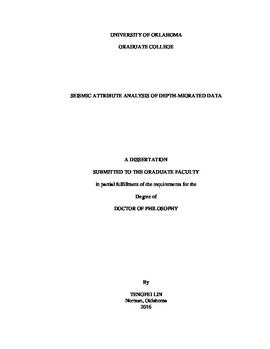| dc.description.abstract | Most seismic attributes are originally designed and computed on time-migrated data. While some papers show the values of attribute analysis on depth-migrated data, few have compared the images to corresponding time-migrated volumes. I therefore use time- and depth-migrated volumes from Bohai Bay Basin, China, to show not only the values of depth-migration, but also the necessary data-conditioning, algorithmic modification, and interpretation of attributes computed from depth data.
Since one of the goals for depth migration is to image steep dips, depth migration also allows steeply dipping noise to overprint the image. I suppress this noise through careful structure-oriented filtering. Fault plane reflections are imaged well by depth migration, and give rise to dips that conflict with those of the underlying reflectors.
In depth-migrated data, spectral components are now measured in cycles per kilometer or cycles per kilofeet (wavenumber) rather than in cycles/s or Hertz (frequency). While smoothly varying velocity models used in Kirchhoff depth migration give rise to smoothly varying wavenumber stretch, discontinuous velocity models used in wave equation and reverse time migration will give rise to wavenumber artifacts straddling the velocity discontinuity boundary. Furthermore, imaging of steep dips results in a shift by cosθ of true to lower apparent spectral components.
In order to quantitatively evaluate the coherence, I follow early work on the significance of events seen in semblance-based velocity spectra and use an F-statistic to quantify the significance of coherence measures at each voxel. The accuracy and resolution of such measures depend on the bandwidth of the data, the signal-to-noise ratio, and the size of the spatial and temporal analysis windows used in their numerical estimation. In 3D interpretation, low-coherence estimates not only seismic noise, but also geologic signal, such as fault planes and channel edges.
Ideally, vertical attribute analysis windows should be scaled by some fraction of the dominant wavelength. Unfortunately, the dominant wavelength increases with depth in time-migrated data due to attenuation. Moreover, since the size of the dominant wavelength changes as a function of velocity in depth-migrated data, a single fixed-sized window may be too large for shallower data and too small for deeper data. Therefore, I construct laterally and vertically smoothly varying analysis windows based on the spectral content of the data resulting in data-adaptive attribute computation.
I demonstrate the value of these algorithmic modifications to a survey acquired over the Bohai Bay Basin, China. The complex faulting gives rise to a laterally variable velocity, so that depth migration of the data is necessary. After data conditioning, I obtain a relatively clean, noise-free, well-focused depth-migrated image. Artifacts in the time-migrated data such as fault shadows give rise to false coherence anomalies, while velocity pull-up and pushdown give rise to false curvature anomalies. These artifacts are minimized and a more accurate image of the fault network is constructed in the depth-migrated data. Finally, structural features such as folds and flexures are directly linked to the depth-structure of the data via the laterally variable velocity model.
Prestack data conditioning, including residual moveout correction, reduction of migration stretch, and suppression of coherent noise, is critical to subsequent prestack inversion and anisotropy analysis. The Radon transform is a powerful noise suppression tool, and is routinely used to suppress multiples. Traditional Radon transforms are often smeared in the transform domain, limiting the signal to noise separation. We prototype a Radon transform based on a matching pursuit method, to minimize smearing and suppress data stretch. Specifically, the algorithm will ask “which Ricker wavelet with which moveout, best represents the seismic gather”. After each estimate, that event is removed from the data, forming a residual. The algorithm will iterate until all events are described. My hypothesis that the wavelet-based Radon transform will provide improved separation between primaries and multiples, which is proved through the application to a marine data volume acquired by KIGAM in the Jeju Basin, Korea. | en_US |
